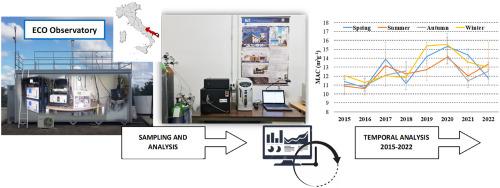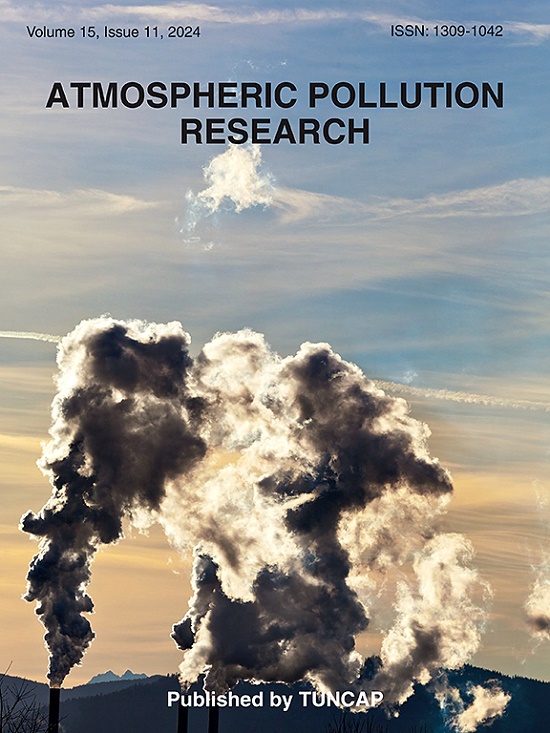对意大利地中海中部一处地点颗粒中碳质组分的长期分析
IF 3.5
3区 环境科学与生态学
Q2 ENVIRONMENTAL SCIENCES
引用次数: 0
摘要
一些研究工作致力于调查大气颗粒物中含碳气溶胶的长期趋势。众所周知,碳会影响气候、人类健康和文化遗产,这也是规划未来政策的重要组成部分。本研究调查了意大利南部(2015-2022)PM2.5和PM10组分中最长的碳含量(EC和OC)数据集。采用多角度吸收光度计(MAAP)测定PM10中每小时的等效黑碳(eBC),并用于评价原位测定的质量吸收系数(MAC)的变化趋势。PM2.5及其OC和EC含量在统计上呈逐年显著下降趋势,自2017-2018年以来,下降幅度约为- 5%,在欧洲其他城市背景点报告的范围内下降。PM10及其碳含量的下降更为有限,约为- 2%,但没有统计学意义(p >;0.05)。时间分析结果表明,季节对PM和碳质物种(包括二次有机气溶胶(SOC)和EC/OC比)浓度格局的影响最为显著,且在冬季和秋季的日变化值最高。这可能是由于生物质燃烧(用于家庭供暖和农业实践)和道路交通在秋冬季节在该地点的贡献较大。原位MAC值为12.4±1.2 m2g-1(几何平均值±标准差)或12.6±2.5 m2g-1(算术平均值±标准差),夏季和初秋较其他季节略有增加。MAC的长期增长趋势为每年2.5%。本文章由计算机程序翻译,如有差异,请以英文原文为准。

Long-term analysis of carbonaceous fractions of particulate at a Central Mediterranean site in Italy
Several research efforts were devoted to investigate long-term trends of carbonaceous aerosols in atmospheric particulate matter. Carbon is known to affect climate, human health, and cultural heritage being an important component also for planning future policies. This work investigates the longest dataset of carbon content (EC and OC) in PM2.5 and PM10 fractions available in south Italy (2015–2022). Equivalent black carbon (eBC) was determined hourly in PM10, using the multi-angle absorption photometer (MAAP), and it was used to evaluate the trend of the mass absorption coefficient (MAC) determined in-situ. PM2.5 and its OC and EC content showed a statistically significant decreasing trend throughout years, since 2017–2018, approximately −5 % yr−1, falling in the ranges reported for other urban background sites in Europe. The decrease of PM10 and its carbon content was more limited, approximately −2 % yr−1 but it was not statistically significant (p > 0.05). Temporal analysis revealed that seasonality played the most significant role in concentration pattern of PM and carbonaceous species, including secondary organic aerosol (SOC) and EC/OC ratio, compared to weekly or daily variabilities, with the highest daily values in winter/autumn. This was likely due to the contributions of biomass burning (for domestic heating and agricultural practices) and of road traffic both larger at this site during the autumn/winter. The value of MAC in-situ was 12.4 ± 1.2 m2g-1 (as geometric mean ± standard deviation) or 12.6 ± 2.5 m2g-1 (as arithmetic mean ± standard deviation), showing a slight increase during summer and early autumn compared to the other season. MAC showed an increasing long-term trend of 2.5 % yr−1.
求助全文
通过发布文献求助,成功后即可免费获取论文全文。
去求助
来源期刊

Atmospheric Pollution Research
ENVIRONMENTAL SCIENCES-
CiteScore
8.30
自引率
6.70%
发文量
256
审稿时长
36 days
期刊介绍:
Atmospheric Pollution Research (APR) is an international journal designed for the publication of articles on air pollution. Papers should present novel experimental results, theory and modeling of air pollution on local, regional, or global scales. Areas covered are research on inorganic, organic, and persistent organic air pollutants, air quality monitoring, air quality management, atmospheric dispersion and transport, air-surface (soil, water, and vegetation) exchange of pollutants, dry and wet deposition, indoor air quality, exposure assessment, health effects, satellite measurements, natural emissions, atmospheric chemistry, greenhouse gases, and effects on climate change.
 求助内容:
求助内容: 应助结果提醒方式:
应助结果提醒方式:


